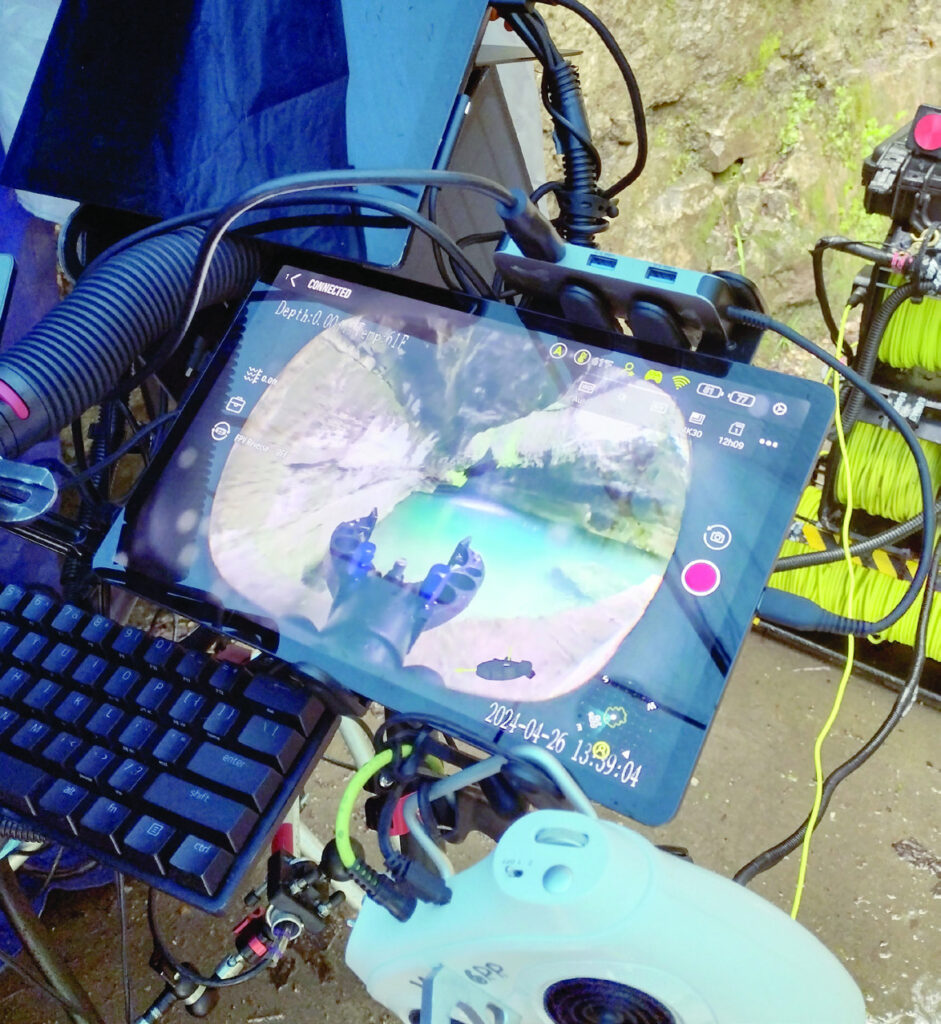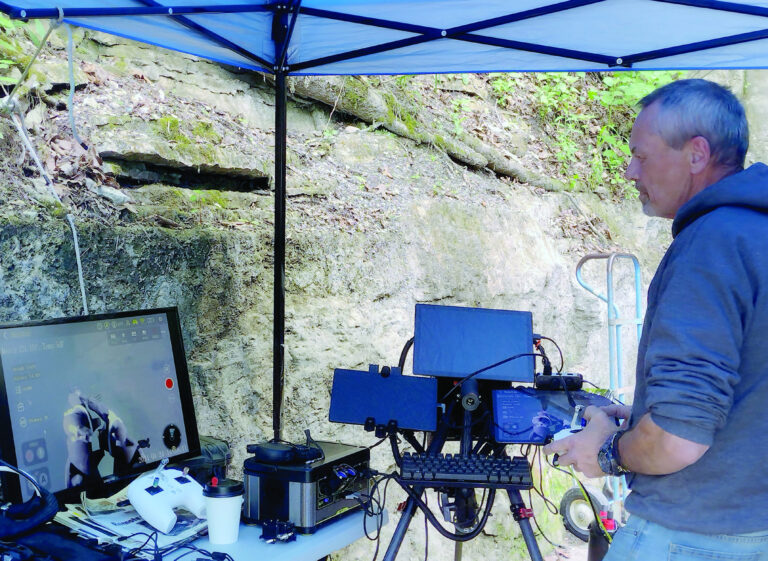
BY SHEILA HARRIS sheilaharrisads@gmail.com
The depth of Roaring River Spring Cave remains a mystery.
Goodspeed Publishing’s “1888 History of Barry County” records the depth to be “fathomless,” but better-equipped explorers later attached more concrete figures to that fathom.
Carol Harvick, front desk associate at Emery Melton Inn and Conference Center at Roaring River State Park, said her grandfather, Ethel Ball, and his brother rowed a boat to the surface of Roaring River Spring in the 1930s, then dropped a weighted line into the water. History, thereafter, recorded a depth of 300 feet: a number which has changed with the development of more precise methods of measurement.
Steve Haggitt, of Prince of Wales Island, Alaska, is the most recent in the line of explorers to pursue the elusive measurement. Haggitt, a commercial diver by trade, has been using remotely operated vehicles (ROVs) to inspect underwater infrastructure and subsurface ecological conditions at pollutant discharge sites for government entities for the past three years. He said much of his work is in multi-level, confined spaces, similar to caves.
Haggitt’s attempt to plumb the depth of the spring was sparked by learning the story of the KISS Rebreathers dive team’s dive of 472 feet into the cave in November 2021. It established Roaring River Cave as the deepest explored spring in the nation at that time.
“I wondered if I could go deeper than they did with my ROVs, without the risk to human life,” he said.
The KISS team’s monthly, weekend diving explorations, which began in May 2021, were curtailed when 27-year-old diver Eric Lee Hahn lost his life in the cave at a depth of 200 feet on Oct. 14, 2022. Hahn’s death was determined to be a result of oxygen toxicity related to an inappropriate mix of gases in his personal tank.
Haggitt submitted an application to the Missouri Department of Natural Resources (DNR) in February to explore and map Roaring River Spring Cave with three submersible ROVs; his application was approved in March.
Haggitt’s permit allowed for a three-day ROV exploration of the cave before May 15. He chose April 24-26 as the dates for his exploration, but because the weather was fair and the discharge rate from the spring was minimal (33 cubic feet per second), Haggitt received the green light from park personnel to begin one day earlier than originally scheduled.
Haggitt’s initial plan called for using three ROVs to video-map the entry-room in the cave on day one, map the restriction in the cave that exists at a depth of 225 feet on day two and descend through the restriction to find “the bottom of the cave,” on day three.
However, due to unforeseen subsurface circumstances and recent inclement weather, Haggitt’s venture is going on 15 days as of Tuesday. The outcome remains unknown.
Tamara Thomsen, maritime archaeologist for the State Historic Preservation Office in Wisconsin, is familiar with the use of ROVs. A technical diver herself, she routinely puts both divers and ROVs to work when researching historic shipwrecks that are found in the bottom of the Great Lakes.
“There are good reasons to use ROVs when researching,” said Thomsen, who said she sometimes spends four hours a day in the water. “The protection of human life is an obvious consideration.
“ROVs can go deeper and remain at depth for extended periods of time in situations that would be next to impossible for humans,” she said.
Data collection is another attribute ROVs have going for them, Thomsen said.
“They can collect hours of data, including multiple 4K photos, at speeds and in depths that humans could never accomplish,” she said.
However, Thomsen believes there is a place for both divers and ROVs in underwater research.
“With ROVs, we’re limited to the frame of what its camera can see,” Thomsen said. “So, in that sense, they’re no replacement for a diver. Plus, ROVs can cause damage to historical artifacts, simply because they’re a machine.”
Thomsen cited the example of the mast of a historic underwater shipwreck being toppled by the tether of an ROV.
ROVs and divers should work hand in hand, without one canceling out the other, Thomsen believes.
“I’ve worked on a lot of projects where that’s the case,” she said. “A diver can take an ROV down to a safe diving level, then turn it loose to continue the descent.”
Thomsen said there have also been times when she wished she had an ROV strapped on her shoulder to record data from what she was seeing in real time.
In spite of their attributes, Thomsen said ROVs do have a large vulnerability, particularly in confined environments. The tethers that typically connect them to operators on the surface are subject to entanglement, she said.
“Getting entangled in divers’ [survey] lines is just par for the course when operating ROVs,” she said,. “[It’s] just something you should expect.”
Divers attach guide lines to cave walls so that they can find their way back to the surface, and also for mapping purposes, as they did in Roaring River Cave.
KISS Rebreathers cartographer Jon Lillestolen said the team laid about 2,200 feet of nylon survey line in Roaring River Cave.
“In addition to our own line, we used line that was still in place from the divers who explored the spring about 30 years ago,” said Lillestolen, who believes the total amount of line is about 2,500 feet.
It’s a common practice for divers to leave secured guidelines in place in caves to facilitate future explorations. As long as they are not cut, they typically remain in place and pose no problems, Lillestolen said.
In the case of Roaring River Hatchery, Assistant Superintendent Terry Gerke said he has no concerns about the possibility of loose dive lines surfacing in the spring.
“Our new screening and filtration equipment will take care of anything that surfaces,” he said.
According to Lillestolen, all of the survey lines were securely in place when the team abruptly ended their mission.
Dave Porter, who explored Roaring River Spring Cave in the mid-1980s, along with fellow divers, Roger Gliedt and videographer Dee Burks, said he laid new, braided- nylon line in the cave during that exploration.
“It’s the best kind to use for survey lines,” Porter said. “I don’t believe we found any line remaining from previous divers.”
Prior to Porter, divers R.L. Miller and R.F. Fogarty explored the spring in 1979 and charted its depth as 215 feet.
Miller and Fogarty are commonly believed to be the first divers to explore Roaring River Spring. However, former Roaring River Hatchery Manager Paul Spurgeon has in his possession a news clipping depicting divers splashing around in the spring in 1966.
While Haggitt’s plan to map and create a 3-D model of the upper chamber of the cave appeared well thought out, it may not have factored in the existence of the survey lines left in place in the cave by the KISS team — a “ghost net,” as Haggitt calls them.
The first ROV Haggitt sent down into the cave made a successful descent and produced a beautiful video, but its tether became entangled in dive lines when he attempted to bring it back to the surface. Haggitt managed to free the vehicle the following day by sending a second vehicle down to cut the line that was holding it. The next day, however, brought déjà vu. After descending to the restriction, the first ROV again became entangled in dive lines. Following the pattern from the day before, he sent a second vehicle down for the purpose of detangling the first one. However, after a bit of maneuvering, the second one, too, seemed incapable of re-ascending. Opting to call it a day, Haggitt left them both at an approximate depth of 155 feet, subsurface, with plans to recover them the following day.
Mother Nature, however, was not cooperative.
The water discharge rate from the spring, which had idled at approximately 35 cubic feet per second (cfs) for days on end, revved up to well over 300 cfs (after peaking at over 1,000) after an overnight storm, the night after the possible double-entanglement brought much-needed rain to the area.
After waiting several days for the flow to recede to 100 cfs, Haggitt is now waiting for the water’s visibility to clear before making a recovery attempt.
In spite of daunting circumstances, Haggitt remains optimistic. He checks the water at the spring every three hours, in hopes that the water is settling enough for him to see his way to clear to send a third vehicle down to “snip one little line” and free the first two vehicles.
“The ROVs can remain submerged at depth, indefinitely, without damage,” Haggitt said.
In spite of his words, sending a pricey ROV into unknown subterranean territory while watching its progress on the monitor of an electronic device seems as though it could make an operator queasy from stress. Haggitt, however, appeared calm, although the silence was palpable as viewers watched the mesmerizing and slightly surreal descent of the ROV from over Haggitt’s shoulder.
Haggitt currently has data from the submerged ROVs that was translated upward via cable, and he expects to recover 4K imaging from the vehicles after they are extracted from the water.
The video imagery from Haggitt’s first delve into Roaring River Spring Cave can be found on his Facebook page at “ROVDiver.”
What may follow is yet to be determined.






